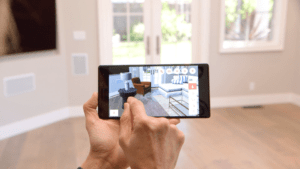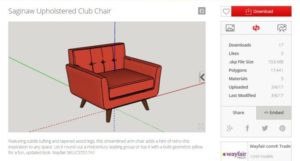On the heels of rival home furnishings retailer Wayfair Inc., Williams-Sonoma is jumping into the 3-D viewing arena in the hopes that enabling shoppers to visualize how furniture will look in their own rooms will prompt them to purchase more.
Williams-Sonoma Inc., No. 21 in the Internet Retailer 2016 Top 500 Guide, this week announced “3D Room View” for its Pottery Barn brand. The tool is an augmented reality app powered by Google Inc.’s Tango technology. Customers must have a Tango-enabled smartphone such as the Phab 2 Pro from electronics manufacturer Lenovo or the Asus Zenphone AR to use the app.

3D Room View, available in the Google Play Store, for now focuses on living rooms and will add spaces over the next 12 months. The app allows customers to launch their smartphone cameras and point the device in the area where they would like to visualize the product. The shopper can then add products to an existing room in her home, enabling her to see how new Pottery Barn and PBteen products will look with current furniture and decor, or she can empty the room to start the design process from scratch. Customers can add, move and remove furniture, rugs, lamps and pillows, change the color of the upholstery or pillows, and zoom in to see details or finishes.
Williams-Sonoma also launched 3-D design and visualization tools—Design Your Perfect Desk for PBteen and 360 Spin for Pottery Barn—for each brand’s desktop and mobile sites. With Design Your Perfect Desk, PBteen customers can pick a desk and build a room around it, from the paint color on the walls to accessories on the desk. With 360 Spin, customers can view a Pottery Barn sofa from all angles, with 120 sofa styles available to start and more added every week.
Pottery Barn will also roll out a pilot program this spring, starting in the San Francisco area, as an add-on to its design services program. Customers can make a one-on-one appointment with a Pottery Barn design specialist equipped with Google Tango phones to test ideas and find inspiration for their homes.
“Our brands have always been a source of inspiration for customers, and we’re excited to enhance that experience by introducing the latest AR technology and visualization tools to help customers design a room by envisioning how Pottery Barn products will look and fit in their actual space,” says John Strain, executive vice president and chief digital and technology officer for Williams-Sonoma.
Online sales at Williams-Sonoma Inc. increased 4.4% in fiscal 2016 ended Jan. 29 to $2.63 billion from $2.52 billion in fiscal 2015, the company reported last week. Total sales for the fiscal year were flat at $2.450 billion from $2.454 billion. E-commerce accounted for 51.8% of total sales for the year compared with 50.7% in fiscal 2015.
This year, Williams-Sonoma will continue to invest “heavily” in digital technology and look into offering a buy online, pick up in store service, CEO Laura Alber said in the retailer’s earnings conference call. “We’ll be implementing digital tools such as next-generation product information pages, 3-D product visualization and increased personalization to deepen online engagement of both new and loyal shoppers and to further expand loyalty across our strong and diverse portfolio brands,” she said.
The move into 3-D and augmented reality tools follows similar steps by home furnishings e-retailer Wayfair (No. 24 in the Top 500). Last year Wayfair launched WayfairView, an augmented reality Android app that lets shoppers view products in their homes.
In the WayfairView app, which is separate from Wayfair’s core shopping app, a consumer can select a product to view in 3-D. Her smartphone’s camera will launch and the shopper points her device in the area of her home where she would like to visualize the product. She taps on the screen where the floor is to orientate the object. The product image then downloads to her smartphone and a few seconds later the consumer can see a 3-D image of that product on her screen where it would be in her physical space. Wayfair’s tool also uses Google Tango technology.
Wayfair has invested heavily in developing and promoting augmented reality and virtual reality tools and features. For example, it recently made 1,000 of its 3-D produ ct models available to professionals using 3-D modeling software SketchUp. SketchUp is a warehouse of 3-D product images used by architects, engineers, designers and construction professionals. By working with SketchUp, Wayfair aims to get more eyeballs on its products by making it easy for to design professionals and architects to use its 3-D product models.
ct models available to professionals using 3-D modeling software SketchUp. SketchUp is a warehouse of 3-D product images used by architects, engineers, designers and construction professionals. By working with SketchUp, Wayfair aims to get more eyeballs on its products by making it easy for to design professionals and architects to use its 3-D product models.
Wayfair also last year launched an application program interface (API) that enables virtual reality and augmented reality app developers to populate their apps with any of Wayfair’s some 10,000 3-D modeled products and launched a virtual reality app called Patio Playground to let consumers design an outdoor patio area.
Other VR/AR moves from Wayfair include IdeaSpace, a virtual reality app for Google’s Daydream VR platform. Wayair also in December added a visualization tool to its flagship shopping app called “View in Room.” That feature enables shoppers to tap a button that appears underneath the product image in Wayfair’s iOS and Android shopping app to launch her smartphone camera and see the product she is looking at in camera mode. The consumer can move the product around with her finger, making it bigger or smaller and adjust the angle.
Katie Evans and April Berthene contributed to this report.